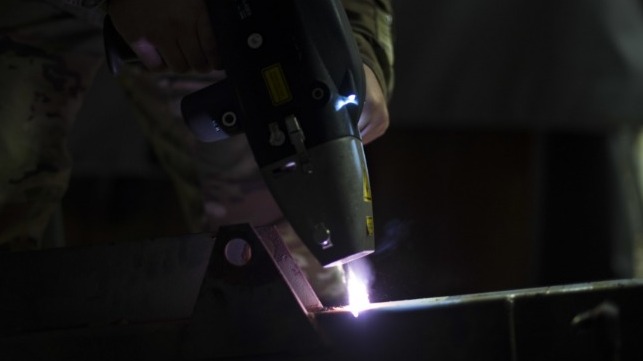Good News For Sailors: High Tech Lasers Could Replace Needle Guns

The U.S. Navy is testing out a new solution to the age-old problem of prepping for painting. Instead of chipping, sandblasting or hydroblasting, it is adopting technology from the aerospace sector: laser ablation.
Teams at Puget Sound Naval Shipyard are already using a laser paint stripping system that was originally developed by Missouri-based tech company Adapt Laser for use on aircraft components. The device peels off rust, paint, oil and other contaminants without leaving any residue or damaging the substrate. Instead of a dust of chips, rust and blasting grit on the surface, it leaves clean and ready-to-paint bare steel, according to the Navy.
7th Fleet's shipyard at Yokosuka (Ship Repair Facility and Japan Regional Maintenance Center, or SRF-JRMC) is looking at bringing laser ablation into its yard in order to improve conditions for its workforce and accelerate its workflow. When considering prep time, the stripping process and post-stripping cleanup, laser ablation may be faster than some traditional surface preparation processes, according to Naval Sea Systems Command (NAVSEA).
Naval Undersea Warfare Center Keyport and Puget Sound Naval Shipyard (PSNS) trialed the use of laser ablation aboard the aircraft carrier USS Carl Vinson in October 2019, and they were pleased with the results. “Laser ablation technology leaves a completely clean surface, and there is no additional need to use solvents or chemicals to remove any oils, grease, or other surface contaminants. [We can] use laser ablation technology [to] reduce exposure to harsh solvents or chemicals and improve worker ergonomics," said Scott Castro, general foreman for Shop 71, Painters Blasters and Tilesetters at PSNS.
One area for future study: laser ablation creates new and different chemical reactions during the removal process, and these will need to be evaluated for air quality considerations, according to chemical engineer Dr. Kraig Frederickson of Naval Undersea Warfare Center Keyport.
Naval Sea Systems Command is testing laser ablation tools and preparing training materials to enable the system's adoption at other shipyards and maintenance centers, and it could one day be seen in use across the fleet. The first priority is on handheld applications that could eliminate needle guns for work in confined areas - good news indeed for any sailor.
